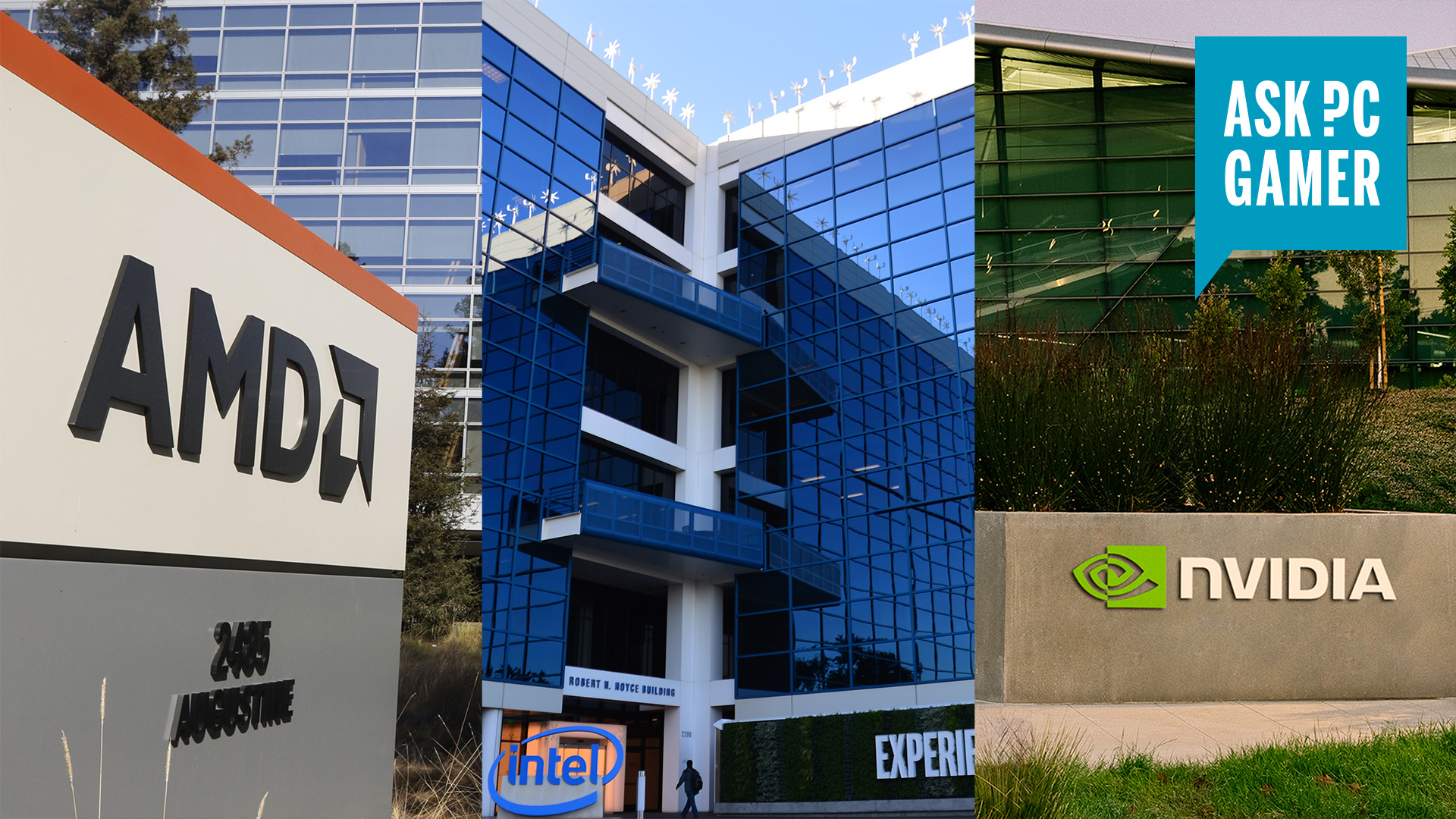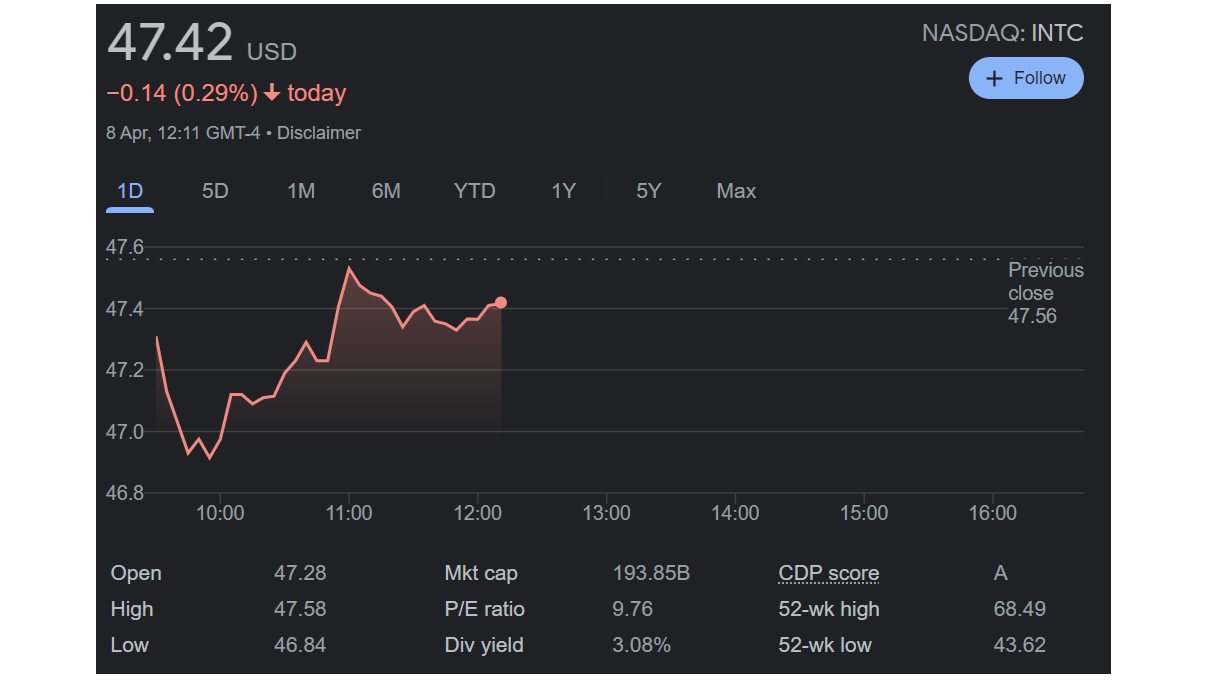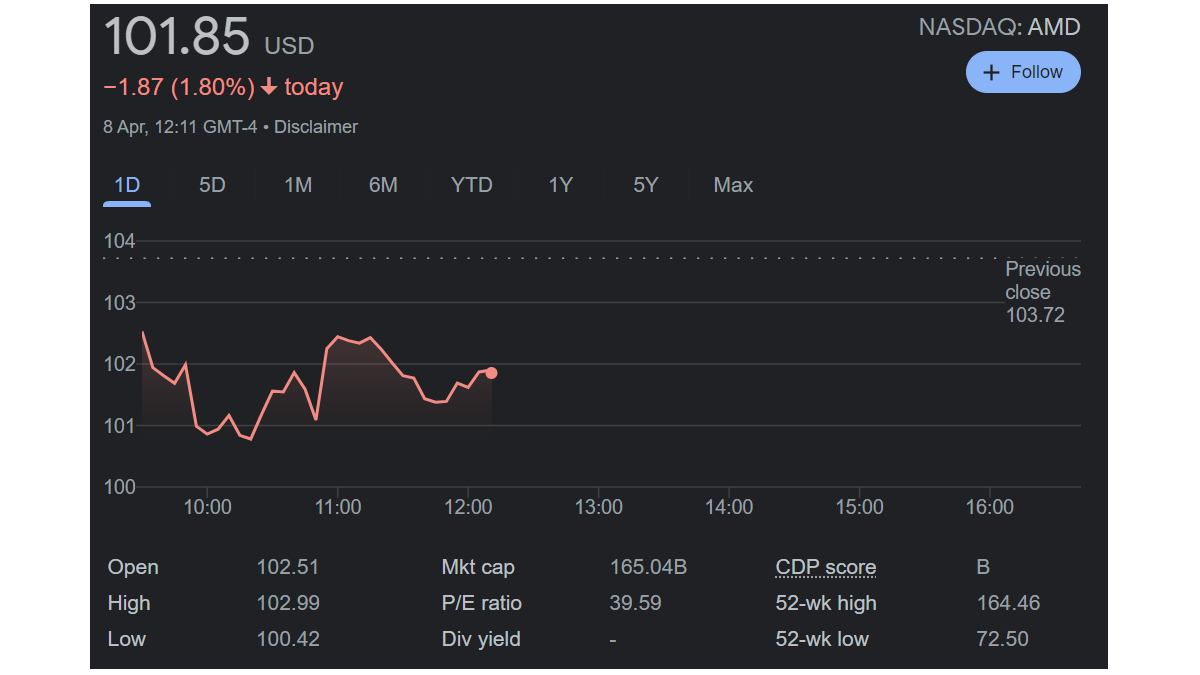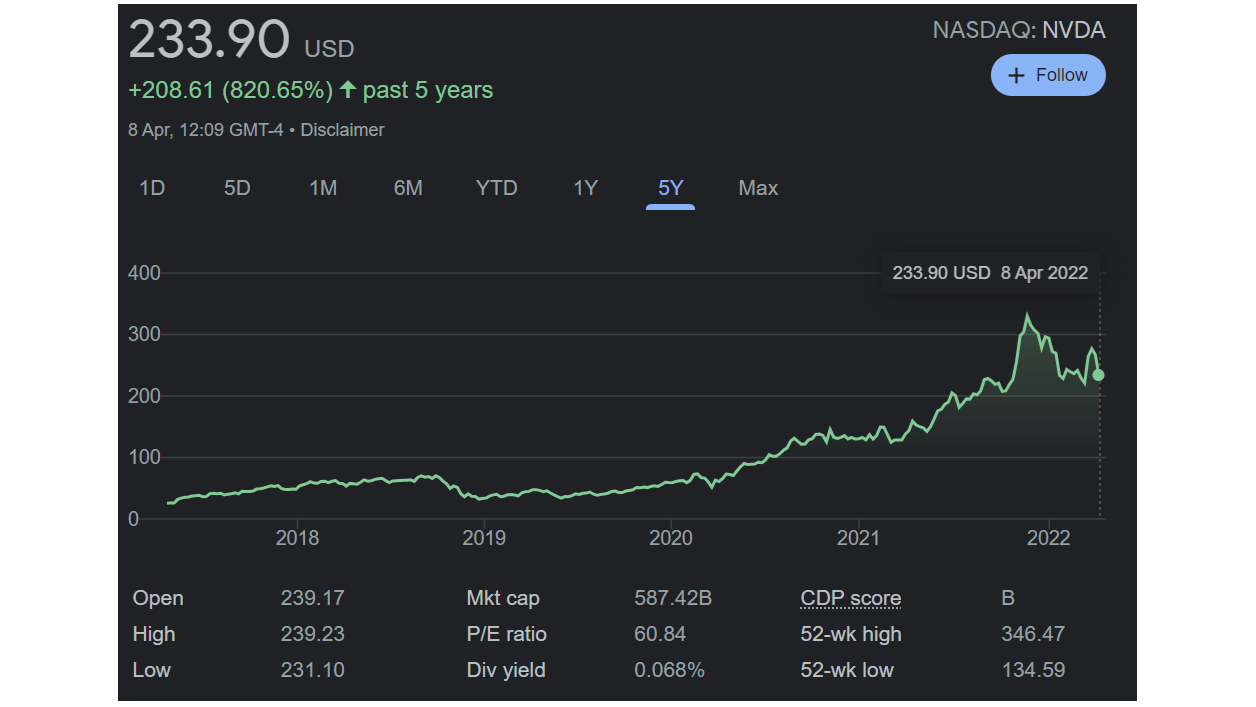Which is the bigger company: AMD, Nvidia, or Intel?
Nvidia is worth over $400B more than Intel, but is far from a match for its size.

We hear an awful lot about share price when it comes to comparisons between Intel, AMD, and Nvidia. It's a news story when AMD is valued at more than Intel, as much as it is when Nvidia skyrockets to new heights of Wall Street wealth. But when it gets down to who's bigger than who, the perceived value of a company doesn't equate to its actual size—that comes down to how many people they employ, revenue streams, the breadth of what they create, and market share.
Stellar financials are one thing, but people make the product; as Intel likes to say, "The ingredient we begin with is sand. Everything else is value added by people." It's true, though, and while a great measure of success is the value attributed to a company, there's a lot more to say when it comes to the scope and size of a company.
That's why I've dug into Intel, AMD, and Nvidia's financials, reports, and corporate documents to see how these three companies actually align in 2022. If you're purely a share price buff, you might be surprised. Though if you're a long-term PC gamer with one eye on hardware, you could probably make a bet right now as to which company is actually the biggest with decent odds of it being correct.
Round one: Employee count
Intel
Intel had 110,600 employees as of December 2020, a figure provided by Intel in its 2020–2021 corporate responsibility report. Intel says roughly 90% of its staff are in technical positions. While we don't have a 2021–2022 report as of yet, I would guess that the number of employees, especially those in technical positions, may have increased under the leadership of Intel's current CEO, Pat Gelsinger. Gelsinger is himself an engineer, and has on numerous occasions championed technical expertise at Intel—a number of notable ex-Intel employees returned when Gelsinger took over.
AMD
AMD totals 12,600+ employees, according to its 2020–21 corporate responsibility report, which offers us a pretty good ballpark figure to go off. Clearly, Intel's staff numbers far exceed that of AMD, though we're forgetting one thing: AMD closed on its Xilinx purchase in 2022; AMD gained around 5,000 employees, or just under, with that acquisition. That means AMD's total headcount will be at least 17,000, if not higher, in 2022.
The biggest gaming news, reviews and hardware deals
Keep up to date with the most important stories and the best deals, as picked by the PC Gamer team.
Nvidia
We're at the whims of Nvidia's strange corporate calendar for its headcount, meaning we're awaiting its full-year 2022 report in a few months—Nvidia's financial year is a year ahead of everyone else, and it doesn't quite add up on a month-by-month basis, either.
For now, we have the 2021 report to go from, which says Nvidia has around 18,975 employees. It also recently expanded its headcount rapidly as the result of an acquisition—Nvidia purchased Mellanox in mid-2020, and you can see the major jump in its total employees as a result. In Nvidia's FY20, it had 13,775 employees. By FY21, it has 18,975.

Round two: Revenue
Intel
When discussing cashflow, Intel sets a mighty high bar. It raked-in $79 billion US dollars in its full-year 2021 period (which ends December 25, 2021), which was up just 1% on 2020's $77.9B figure. A humongous load of cash, no doubt about that. Of that figure, around $19.9B of it was net profit.
AMD
AMD does us a big favour by also running its full-year 2021 until December 25, 2021, meaning it's an apples to apples comparison with Intel for the period. AMD made $16.4B, which is near-enough five times less than Intel. Of that sum, $3.16B was profit. However, there is more to say on that. AMD's full-year results for 2021 were up an absurd 68% year-over-year. The company made $9.8B in 2020. At that rate of growth, AMD would be nearly neck-and-neck with Intel in three years' time.
Whether AMD can keep up this incredible trajectory is another matter. It's a massive ask and the semiconductor biz is anything but consistent. That said, it's definitely looking up for team red as it stands today.
Nvidia
Nvidia is a real Wall Street darling; its total market cap (its share value multiplied by its total outstanding shares) is by far the largest of the three at $614B (AMD sits at $166B and Intel at $193B). Though when you take a look at its actual revenue for a full-year period, it paints an entirely different picture.
For Nvidia's fiscal year 2022—roughly equivalent to AMD and Intel's full-year 2021, ending on January 30, 2021—the company made $26.9B in revenue. That's up a stunning 61% year-over-year, beating full-year 2021's total of $16.7B. Of that sum, $9.75B was net profit, which shows Nvidia runs a tight ship and makes a lot of cash from a fairly lean operation.
Like AMD, Nvidia has gained tremendously over the past year, and both companies make Intel's 1% improvement during the period look rather paltry by comparison. Despite this, it is Intel that's far ahead in overall revenue.

Round three: Products
While PC gamers know Intel, AMD, and Nvidia for their PC hardware components—namely GPUs or CPUs—these companies don't entirely operate within the same exact space. For all the acquisitions and sub-divisions made by these three, it's not all that easy to draw a firm comparison between them without also looking into what products and services they provide.
It's also worth noting that Intel has the facilities to produce its own chips, and that's a whole different ballgame to AMD and Nvidia. Both of which are fabless companies and reliant on the manufacturing capability of others to produce their chips. Of course, Intel does rely on other chipmakers, too—we're largely talking about TSMC and Samsung here—but maintains a large chip fabrication presence globally.
I'm not going to list every product each company makes; I'd be here all year and it'd be wrong by the time I'd finished. Instead I'll give a rough idea of the purview of each of these companies and their main products.
Intel
- CPUs - Server + client
- GPUs - Intel Arc, Xe architecture, etc.
- Mobile - Intel 12th Gen mobile processors
- SSDs - NAND Flash (until completion of purchase by SK Hynix)
- Memory - Optane (potentially on the chopping board, predicted to end up with a $529 million operating loss in 2021.)
- Automotive - Mobileye
- Connectivity - Killer, Intel Wi-Fi, Intel Ethernet, Thunderbolt
- Chipsets
- FPGAs
- ASICs - Blockscale, eASIC
- Manufacturing - IDM 2.0
- Software - OneAPI suite, Command Center, XeSS, etc.
- Supercomputers
AMD
- CPU - Server + client
- GPU - Radeon RDNA, CDNA, etc.
- Mobile - Ryzen 6000 mobile processors
- Software - Adrenalin Software, FidelityFX suite, ROCm, Ryzen Master, etc.
- Chipsets
- FPGAs, SoCs - Xilinx
- Supercomputers
Nvidia
- GPU - GeForce, Quadro, datacentre
- CPU - Grace
- Monitors - G-Sync modules
- Robotics - Jetson
- Automotive - Drive,
- Supercomputers
- Medical devices - Clara
- Software - CUDA, DLSS, GeForce Now, etc.
- Datacentre - Mellanox, DPUs, etc.

Round four: Market share
We can't necessarily compare all three companies in their market share, because, as we've just seen, they compete in many different categories. However, we can take a look at the market share of those products that matter most to PC gamers, namely CPU and GPU.
In terms of gaming market share, we can look to the Steam Hardware Survey for an idea. Just bear in mind that this isn't the ideal metric to draw firm conclusions from; more of a rough idea of general trends.
Total CPU market share (Mercury Research - Q4, 2021)
- Intel: 74.4%
- AMD: 25.6%
Gaming (Steam Hardware Survey - March 2022)
- Intel: 69.34%
- AMD: 30.66%
Total dGPU market share (Jon Peddie Research - Q4 2021)
- AMD: 19%
- Nvidia: 81%
Gaming (Steam Hardware Survey - March 2022)
- Intel: 8.52%
- AMD: 14.15%
- Nvidia: 77.13%



Bonus round: Market cap
Alright, I know we said we wouldn't look at the world through this lens, but we are mostly suckers for cash money, ultimately. When it comes to share price, or the perceived value of a company by the public, the aforementioned dominance of Intel is far less pronounced. In fact, it's valued at less than a third of Nvidia.
Market cap (as of April 2022)
- Intel: $193 billion
- AMD: $166 billion
- Nvidia: $614 billion
Nvidia is clearly a company perceived to be more valuable than its competitors, though there are other factors to its success to consider. Share price valuation can fluctuate quite significantly due to events and circumstance that might not accurately reflect the real-life success or danger to a companies' prosperity. While an interesting factor, and no doubt one of significant import to shareholders that may hold the keys to a company's leadership, in the long-run we'll have to see whether Nvidia's share price dominance materialises as bigger numbers in its financial results, too.

The biggest of the three: Intel
It's not altogether surprising that Intel is so clearly the larger of the three companies. It pretty much built the computer chip as we know it today, and it's never ceased in manufacturing its own designs since those hazy days of chipmaking history. There's a legacy there, and that legacy is still worth its weight in gold. Or at least Olympic-size swimming pools of cash every quarter.
However, Nvidia and AMD remain strong competition despite their overall size and revenue discrepancies; the public appears to be well aware of this too, judging by each company's market cap. Nvidia, especially, has been doing exceptionally well these past two years, and by at least the perception of its shareholders and the public would be considered the more successful of the three.

Best CPU for gaming: The top chips from Intel and AMD
Best gaming motherboard: The right boards
Best graphics card: Your perfect pixel-pusher awaits
Best SSD for gaming: Get into the game ahead of the rest
I would guess that Intel's unique position among the three as the manufacturer of its own goods, and the recent interest from US and European leaders for that capability, will allow it to continue to lead the way in these key areas—even though it might not seem that way today with its far slower yearly growth. In a world of supply chain constraints and interglobal competition for chips, Intel is uniquely positioned to deliver what the others can't, even if it hasn't appeared to materialise many gains in that department over the past half decade or more.
Despite the competition, the future also looks at least partly co-operative for the big three. Intel's IDM strategy puts it at the centre of a cross-continent pledge to increase domestic chipmaking, and that would likely see Intel less at odds with Nvidia and AMD, and more closely working with them. It's not entirely unbelievable that we will one day see an AMD or Nvidia chip manufactured by Intel; though it would be quite odd to see all the same.

Jacob earned his first byline writing for his own tech blog. From there, he graduated to professionally breaking things as hardware writer at PCGamesN, and would go on to run the team as hardware editor. He joined PC Gamer's top staff as senior hardware editor before becoming managing editor of the hardware team, and you'll now find him reporting on the latest developments in the technology and gaming industries and testing the newest PC components.

